

Article Critique
Ai generator.
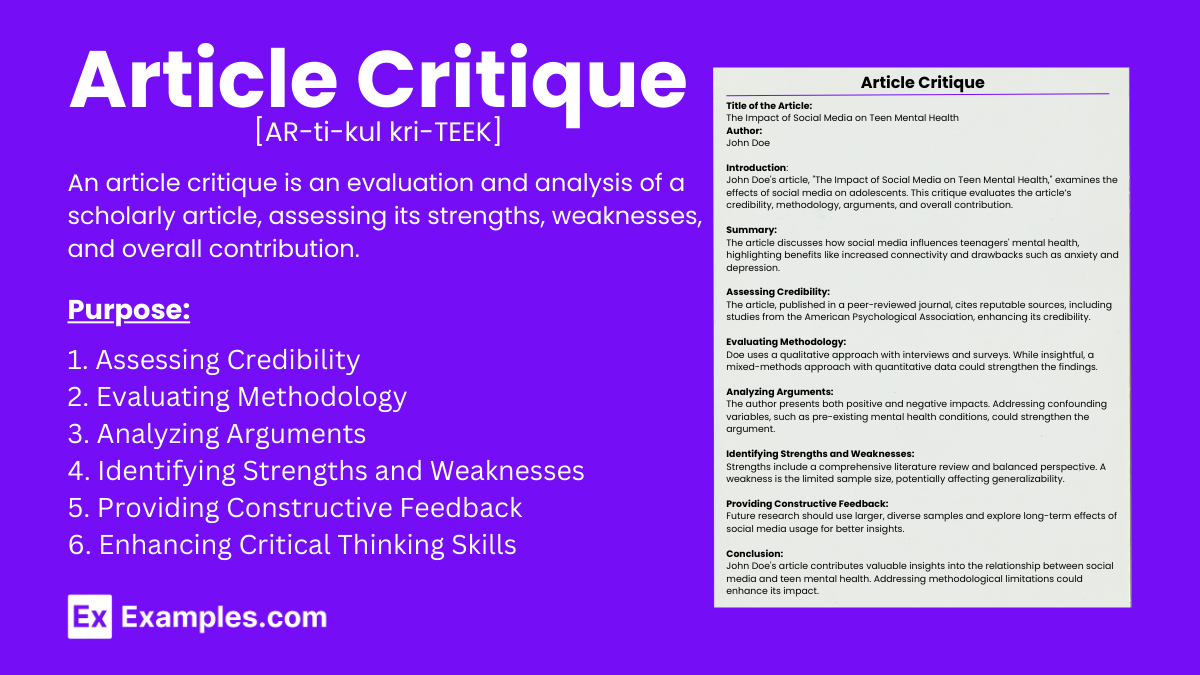
In the realm of academia and intellectual discourse, the art of critiquing articles holds significant importance. It not only refines one’s skills but also contributes to the growth of knowledge. A well-executed article critique showcases your ability to analyze, evaluate, and engage with scholarly work. This article delves into the concept of article critiques, offering insights into their purpose and benefits, along with a step-by-step guide on how to craft one effectively.
What is an Article Critique?
An article critique is a detailed evaluation and analysis of a scholarly article or research paper . It involves an objective assessment of the author’s arguments, evidence, methodology, and conclusions. An effective critique goes beyond summarizing the content; it delves into the strengths, weaknesses, and implications of the article. Developing this skill allows you to identify the characteristics that contribute to a compelling scholarly work, while also honing your ability to engage critically with academic literature.
Article Critique Format
1. introduction.
- Article Information : Mention the title of the article, the author’s name, the source ( journal , magazine , etc.), and the publication date.
- Thesis Statement : Summarize the main argument or purpose of the article.
- Scope of the Critique : Briefly outline the main points you will discuss in your critique.
2. Summary of the Article
- Main Points : Summarize the key points and arguments presented by the author.
- Purpose and Scope : Explain the purpose of the article and the main topics covered.
- Findings and Conclusions : Highlight the primary findings and conclusions drawn by the author.
3. Critical Analysis
A. structure and organization.
- Introduction : Evaluate the effectiveness of the introduction. Does it set the stage for the article?
- Body : Assess the organization of the main sections. Are the arguments and evidence presented logically?
- Conclusion : Examine the conclusion. Does it effectively summarize the article and provide closure?
b. Content and Arguments
- Clarity : Determine if the article is clear and easy to understand.
- Evidence : Analyze the evidence used to support the arguments. Is it relevant and convincing?
- Consistency : Check for logical consistency in the arguments.
c. Research Methodology
- Approach : Evaluate the research methods used in the article. Are they appropriate for the research question ?
- Data Collection : Assess the reliability and validity of the data collection methods.
- Analysis : Examine the thoroughness and accuracy of the data analysis .
d. Writing Style
- Tone : Assess the appropriateness of the tone for the target audience.
- Language : Evaluate the use of language. Is it precise and concise?
- Grammar and Syntax : Check for grammatical correctness and syntactical clarity.
e. Contribution to the Field
- Originality : Determine the originality of the article. Does it offer new insights?
- Impact : Assess the potential impact of the article on the field. Does it advance knowledge or understanding?
4. Personal Response
- Strengths : Identify the strengths of the article. What did the author do well?
- Weaknesses : Point out the weaknesses or areas for improvement.
- Overall Impression : Provide your overall impression of the article.
5. Conclusion
- Summary : Summarize your main points of critique.
- Recommendation : Offer any recommendations for future research or improvements to the article.
6. References
- Citation : Provide a full citation of the article in the appropriate format (APA, MLA, Chicago, etc.).
- Additional Sources : Include citations for any additional sources referenced in your critique.
Examples of Article Critique For Students
Psychology article critique.
Reference: Smith, J. A., & Brown, R. L. (2022). The impact of sleep deprivation on cognitive performance. Journal of Psychological Research , 34(2), 123-135. https://doi.org/10.1001/jpsychres.2022.01.001 Introduction In their article “The Impact of Sleep Deprivation on Cognitive Performance,” Smith and Brown (2022) examine the effects of sleep deprivation on various cognitive functions. The authors aim to highlight the importance of adequate sleep for maintaining cognitive health and performance. Summary Smith and Brown (2022) conducted a series of cognitive tests on participants who were sleep-deprived for 24 hours. The results indicated significant declines in memory retention, attention span, and problem-solving skills among the sleep-deprived group. The article also discusses potential long-term consequences of chronic sleep deprivation on brain health. Critique Smith and Brown (2022) provide compelling evidence linking sleep deprivation to cognitive decline. Their methodology is robust, featuring a well-defined participant group and controlled variables. However, the study’s sample size is relatively small, which may limit the generalizability of the findings. Additionally, the article does not sufficiently explore potential confounding factors, such as stress and caffeine intake, which could influence cognitive performance. Conclusion Overall, Smith and Brown (2022) effectively underscore the critical role of sleep in cognitive health. Despite some methodological limitations, their findings contribute valuable insights to the field of sleep research. Future studies should aim to address the identified limitations to strengthen the generalizability and applicability of the results.
Education Article Critique
Reference: Johnson, L. M., & White, P. D. (2023). The impact of technology integration on student learning outcomes. Journal of Educational Technology , 29(1), 45-59. https://doi.org/10.1016/j.jeduc.2023.01.002 Introduction In the article “The Impact of Technology Integration on Student Learning Outcomes,” Johnson and White (2023) explore how incorporating digital tools and resources in the classroom affects students’ academic performance. The authors aim to identify both the benefits and challenges of technology integration in education. Summary Johnson and White (2023) evaluate various forms of technology integration, including interactive whiteboards, educational software, and online resources. They analyze the effects of these tools on student engagement, motivation, and achievement across different subjects and grade levels. The study presents data from several schools that have implemented these technologies, showing improvements in test scores and classroom participation. Critique The article by Johnson and White (2023) provides a comprehensive analysis of the positive impacts of technology on student learning. The use of multiple case studies strengthens the validity of their conclusions. However, the study’s focus on urban schools may not reflect the experiences of students in rural or underfunded schools, limiting the generalizability of the findings. Additionally, the reliance on short-term data does not capture the long-term effects of technology integration on student learning. Conclusion Johnson and White (2023) make a compelling case for the positive impact of technology on student learning outcomes. While the article effectively demonstrates the benefits of digital tools, addressing the identified limitations would provide a more comprehensive understanding of technology integration in education. Future research should focus on long-term effects, diverse educational settings, and the challenges of teacher training and equitable access to technology.
Business Article Critique
Reference: Davis, K. L., & Roberts, J. H. (2021). Corporate social responsibility and business success: A review of recent research. Journal of Business Ethics , 38(4), 220-235. https://doi.org/10.1016/j.jbuseth.2021.02.003 Introduction In their article “Corporate Social Responsibility and Business Success: A Review of Recent Research,” Davis and Roberts (2021) explore how corporate social responsibility (CSR) initiatives impact business performance. The authors aim to demonstrate the benefits of CSR in enhancing corporate reputation and customer loyalty. Summary Davis and Roberts (2021) review several studies that analyze the outcomes of CSR initiatives across different industries. The article highlights positive correlations between CSR activities and financial performance, as well as improvements in brand reputation and customer satisfaction. The authors also discuss the potential challenges businesses face when implementing CSR programs. Critique Davis and Roberts (2021) provide a thorough review of the literature on CSR and its impact on business success. The article effectively synthesizes findings from various studies, supporting their argument that CSR can be beneficial for companies. However, the article could be improved by including more critical perspectives on CSR, such as potential drawbacks or instances where CSR initiatives have failed. Additionally, the authors do not provide detailed guidelines on how companies can measure the effectiveness of their CSR efforts. Conclusion Overall, Davis and Roberts (2021) make a strong case for the positive impact of CSR on business success. Their review underscores the importance of socially responsible practices in building a positive corporate image and achieving long-term profitability. Future research should address the limitations noted, particularly by exploring the challenges and failures of CSR initiatives and providing actionable metrics for evaluating their success.
Health Sciences Article Critique
Reference: Nguyen, M. T., & Kim, H. S. (2020). The effects of a plant-based diet on cardiovascular health: A systematic review. Journal of Nutritional Science , 17(3), 95-110. https://doi.org/10.1016/j.jnutrsci.2020.03.005 Introduction In the article “The Effects of a Plant-Based Diet on Cardiovascular Health: A Systematic Review,” Nguyen and Kim (2020) investigate the impact of plant-based diets on heart disease prevention and management. The authors aim to provide evidence supporting dietary recommendations for cardiovascular health. Summary Nguyen and Kim (2020) review multiple studies comparing the cardiovascular outcomes of individuals on plant-based diets versus those on omnivorous diets. Their findings suggest that plant-based diets are associated with lower cholesterol levels, reduced blood pressure, and decreased incidence of heart disease. The authors discuss potential mechanisms, such as reduced intake of saturated fats and increased consumption of fiber and antioxidants. Critique Nguyen and Kim (2020) present a comprehensive review of the cardiovascular benefits of plant-based diets. The inclusion of various studies strengthens the validity of their conclusions. However, the review would benefit from a more balanced discussion of potential challenges, such as the risk of nutrient deficiencies and the social and cultural barriers to adopting a plant-based diet. Additionally, the article focuses primarily on short-term studies, and more research on the long-term sustainability of these diets is needed. Conclusion Overall, Nguyen and Kim (2020) provide strong evidence supporting the cardiovascular benefits of plant-based diets. Their systematic review contributes valuable insights to the field of nutritional science. Future research should address the limitations identified, particularly regarding long-term sustainability and potential challenges in adhering to plant-based diets.
Social Sciences Article Critique
Reference: Lopez, G. R., & Thompson, S. L. (2021). Urban poverty and social policy: Examining the effectiveness of welfare programs. Journal of Social Policy , 43(2), 180-195. https://doi.org/10.1016/j.jsp.2021.04.007 Introduction In the article “Urban Poverty and Social Policy: Examining the Effectiveness of Welfare Programs,” Lopez and Thompson (2021) analyze the impact of various welfare programs on reducing urban poverty. The authors aim to assess the effectiveness of these programs in improving the socioeconomic conditions of urban populations. Summary Lopez and Thompson (2021) evaluate several welfare programs, including food assistance, housing subsidies, and employment training initiatives. Their analysis reveals mixed outcomes, with some programs showing significant positive effects on poverty reduction, while others have minimal impact. The authors discuss factors contributing to these varied results, such as program design, implementation quality, and participant engagement. Critique Lopez and Thompson (2021) provide a detailed analysis of the effectiveness of welfare programs in addressing urban poverty. The article’s strength lies in its comprehensive evaluation of multiple programs and consideration of various influencing factors. However, the study relies on data from a limited number of cities, which may not be representative of broader urban contexts. Additionally, the authors could have included more qualitative data to provide deeper insights into the lived experiences of program participants. Conclusion Overall, Lopez and Thompson (2021) offer valuable insights into the effectiveness of welfare programs in reducing urban poverty. Their findings highlight the need for well-designed and effectively implemented programs to achieve meaningful poverty reduction. Future research should aim to include a more diverse range of urban settings and incorporate qualitative data to enrich the understanding of program impacts.
Examples of Thesis Statements for Article Critiques
Psychology article critique thesis statements.
- “The article successfully links mindfulness practices to reduced anxiety levels, yet it overlooks the potential variability in individual responses, which could affect the generalizability of the results.”
- “While the study provides significant insights into the effects of social media on adolescent self-esteem, its cross-sectional design limits the ability to infer causality.”
Literature Article Critique Thesis Statements
- “The article provides a nuanced analysis of the themes of isolation in ‘Frankenstein,’ but its limited engagement with contemporary critical perspectives reduces its impact.”
- “Although the article offers a compelling interpretation of symbolism in ‘Moby Dick,’ its narrow focus on literary devices neglects the broader socio-political context of the novel.”
Business Article Critique Thesis Statements
- “The article effectively highlights the benefits of agile project management in tech startups, but it fails to consider the potential downsides, such as the risk of scope creep and resource strain.”
- “Despite presenting a well-researched argument for the advantages of remote work, the article’s lack of empirical data on long-term productivity effects weakens its conclusions.”
Health Sciences Article Critique Thesis Statements
- “The article convincingly argues for the role of gut microbiota in mental health, though it would benefit from a more thorough exploration of the mechanisms underlying this relationship.”
- “While the study provides strong evidence for the benefits of intermittent fasting on metabolic health, its reliance on short-term studies limits the understanding of long-term effects.”
Education Article Critique Thesis Statements
- “The article makes a strong case for the use of gamification in education to enhance student motivation, yet it neglects to address potential challenges related to accessibility and equity.”
- “Despite effectively demonstrating the positive impacts of project-based learning on student engagement, the article lacks consideration of the additional resources and training required for successful implementation.”
Environmental Science Article Critique Thesis Statements
- “The article offers a comprehensive review of the impacts of deforestation on climate change, but it would be strengthened by incorporating more case studies from diverse geographic regions.”
- “While the article effectively discusses the potential of urban green spaces to mitigate air pollution, it underestimates the complexities of urban planning and maintenance costs.”
Social Sciences Article Critique Thesis Statements
- “The article provides valuable insights into the influence of cultural norms on gender roles, but its limited geographic focus restricts the applicability of its findings to a global context.”
- “Although the study sheds light on the relationship between economic inequality and crime rates, its reliance on correlational data makes it difficult to draw definitive causal conclusions.”
Example of Article Critique About Education
Article Title : The Impact of Technology Integration on Student Learning Outcomes Introduction The article “The Impact of Technology Integration on Student Learning Outcomes” investigates how the use of digital tools and resources in the classroom influences students’ academic performance. The research aims to identify the benefits and potential drawbacks of incorporating technology into educational settings. Summary The study evaluates various forms of technology integration, including interactive whiteboards, educational software, and online resources. It examines their effects on student engagement, motivation, and achievement across different subjects and grade levels. The article presents data from several schools that have implemented these technologies, showcasing improvements in test scores and classroom participation. Critique The article provides a comprehensive analysis of the positive impacts of technology on student learning. The use of multiple case studies strengthens the validity of its conclusions. However, the article could improve by addressing some critical aspects: Sample Size and Diversity : The study primarily focuses on schools in urban areas, which may not reflect the experiences of students in rural or underfunded schools. Expanding the sample size to include a more diverse range of schools would enhance the generalizability of the findings. Longitudinal Data : The research relies heavily on short-term data, which may not capture the long-term effects of technology integration on student learning. Longitudinal studies are necessary to understand the sustained impact of these tools. Teacher Training and Support : While the article highlights the benefits of technology, it overlooks the challenges teachers face in integrating these tools effectively. Providing adequate training and ongoing support is crucial for the successful implementation of technology in the classroom. Equity and Access : The article briefly mentions the digital divide but does not delve into how disparities in access to technology can affect educational outcomes. A more thorough examination of equity issues would provide a balanced perspective on the advantages and limitations of technology integration. Conclusion Overall, the article makes a compelling case for the positive impact of technology on student learning outcomes. It effectively demonstrates how digital tools can enhance engagement and academic performance. However, to provide a more comprehensive understanding, future research should address the limitations identified, particularly regarding sample diversity, long-term effects, teacher support, and equity issues. By doing so, the research could offer more actionable insights for policymakers and educators striving to harness the full potential of technology in education.
More Examples & Samples Article Critique in PDF
1. quantitative article critique.
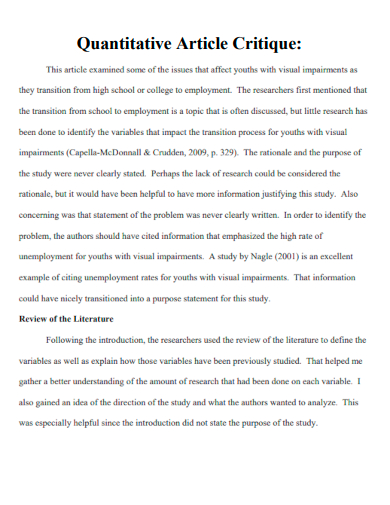
2. Article Critique Guidelines
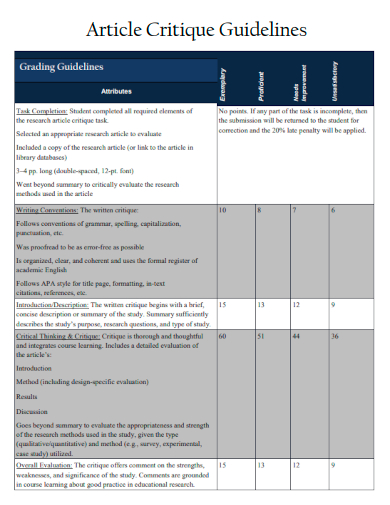
4. Critiquing Research Articles

4. Article Review & Critiques
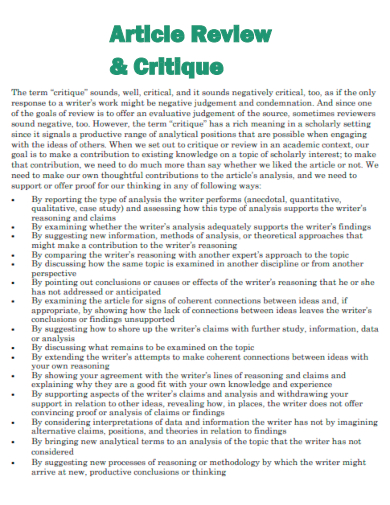
5. Instructions for Article Critiques
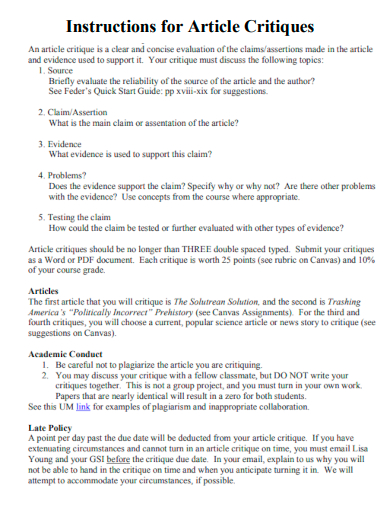
6. Critique of an Academic Article
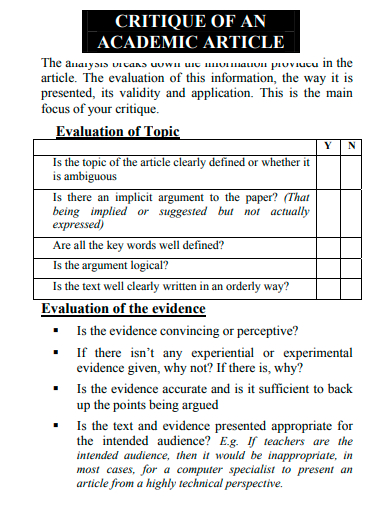
7. Critique and Review of Research Articles
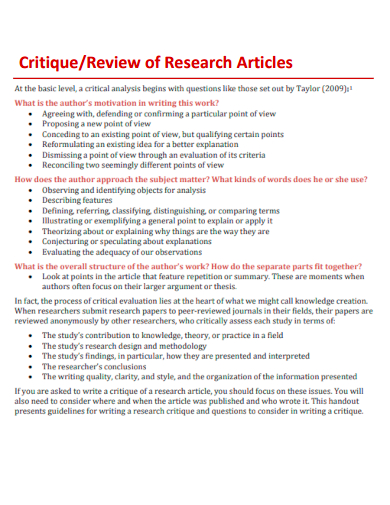
8. Article Critique Assignment
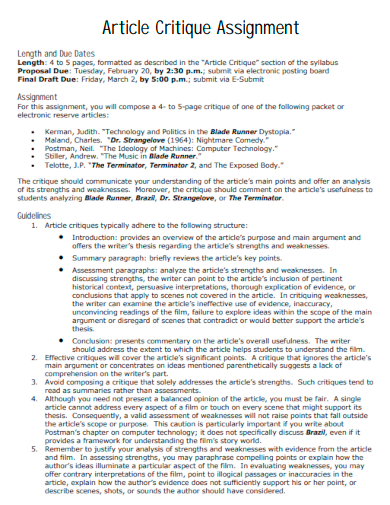
9. Book Review or Article Critique
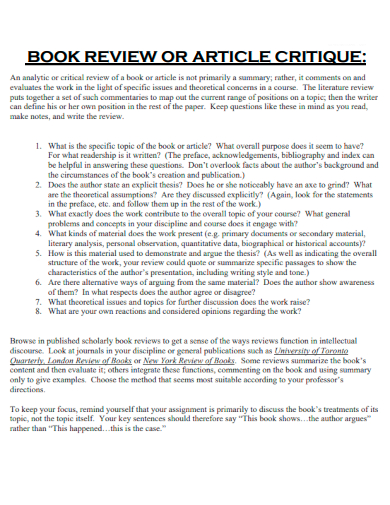
10. Press Article Critique
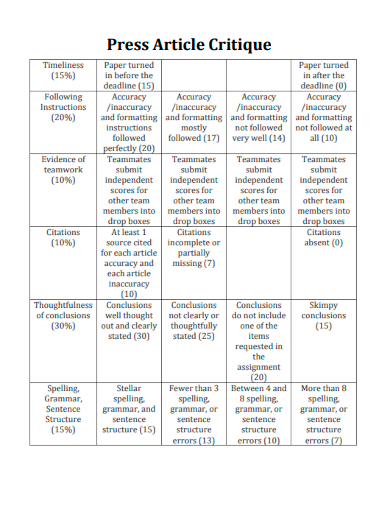
Purpose of Article Critique
An article critique serves multiple essential purposes in both academic and professional contexts. Below, we delve into the primary objectives of conducting an article critique, which are vital for developing critical thinking, analytical skills, and subject-specific knowledge.
1. Developing Critical Thinking Skills
Critical Evaluation:
- Encourages students and professionals to go beyond surface-level reading.
- Promotes a deeper understanding of the material by questioning the validity and reliability of the arguments presented.
Analytical Reasoning:
- Helps in identifying logical fallacies, biases, and unsupported claims.
- Facilitates the assessment of evidence and methodologies used in the article.
2. Enhancing Understanding of Subject Matter
In-Depth Analysis:
- Requires a thorough examination of the article’s content, including the main arguments, evidence, and conclusions.
- Enhances comprehension of complex concepts and theories within a specific field.
Contextual Awareness:
- Places the article within the broader context of existing literature.
- Identifies gaps in the research and suggests areas for further investigation.
3. Improving Academic Writing Skills
Structured Writing:
- Teaches students how to organize their thoughts coherently.
- Develops skills in writing clear, concise, and structured critiques.
Evidence-Based Arguments:
- Encourages the use of evidence to support evaluations and opinions.
- Helps in the practice of citing sources correctly and ethically.
4. Facilitating Peer Review and Feedback
Constructive Criticism:
- Provides a framework for giving and receiving constructive feedback.
- Enhances collaborative learning by engaging in discussions about the strengths and weaknesses of an article.
Quality Assurance:
- Plays a crucial role in academic publishing and professional fields by ensuring the quality and credibility of published work.
- Helps maintain high standards in research and scholarship.
5. Encouraging Lifelong Learning
Continual Improvement:
- Fosters a habit of continuous learning and improvement.
- Keeps individuals updated with the latest research, trends, and advancements in their field.
Adaptability:
- Prepares students and professionals to adapt to new information and changing paradigms.
- Cultivates a mindset that is open to questioning and re-evaluating established knowledge.
Components of an Article Critique
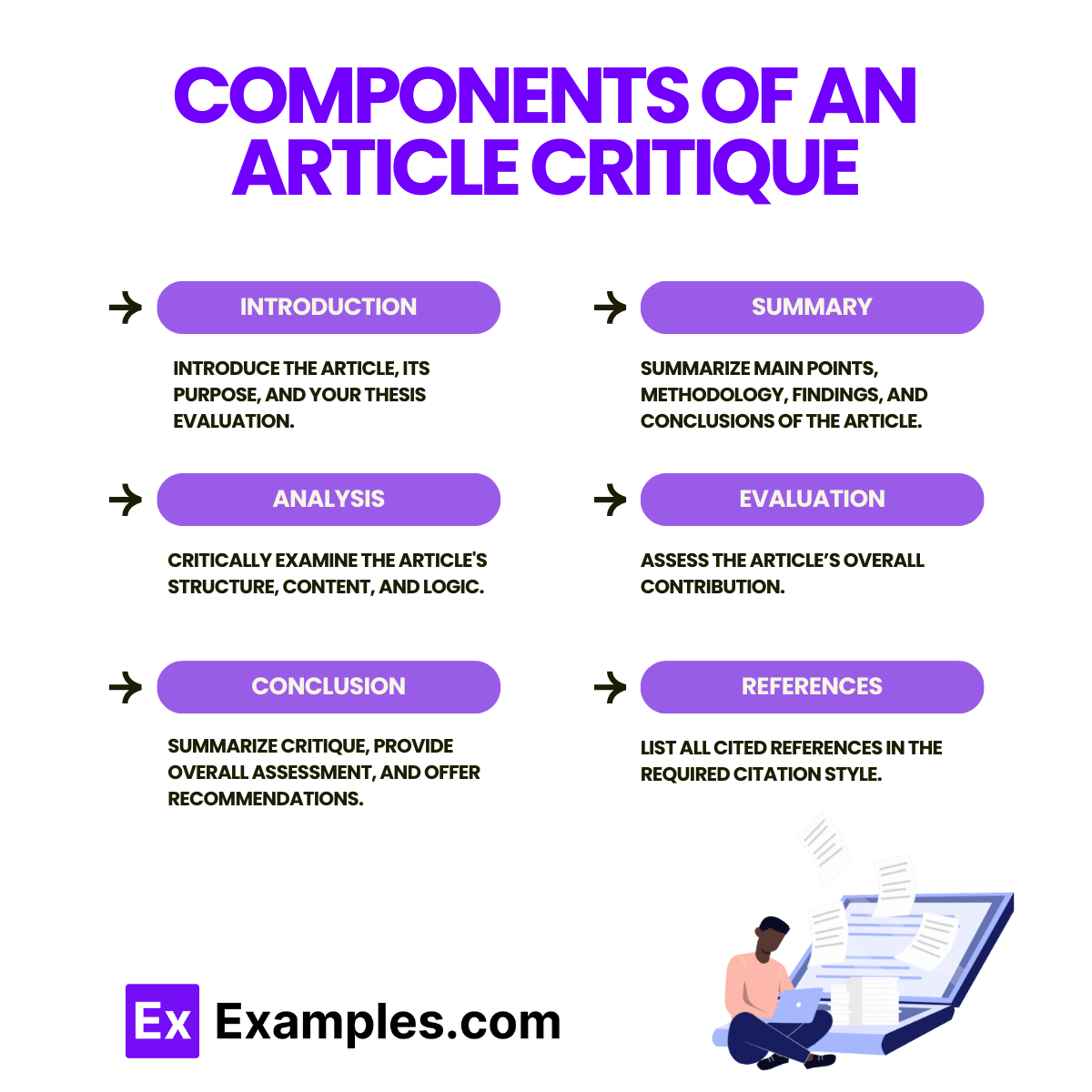
An effective article critique includes several key components to ensure a thorough evaluation and analysis. Below are the main components:
- Provide an overview of the article.
- Introduce the main thesis and key points.
Components:
- Title and Author: State the article’s title and author.
- Publication Details: Include publication name, date, etc.
- Thesis Statement: Summarize the article’s main argument.
- Purpose of the Critique: Explain your objective.
- Summarize the article’s content.
- Main Points: Highlight key arguments.
- Methodology: Describe research methods briefly.
- Findings and Conclusions: Outline main findings and conclusions.
3. Analysis
- Critically examine the article’s structure, content, and logic.
- Structure and Organization: Evaluate clarity and coherence.
- Content Evaluation: Assess relevance and depth.
- Argumentation: Analyze logical flow and evidence strength.
- Methodology: Critique research methods and identify biases.
- Sources and References: Evaluate quality and relevance of cited sources.
4. Evaluation
- Assess the article’s overall contribution.
- Strengths: Highlight strengths such as originality and depth.
- Weaknesses: Identify weaknesses like gaps and biases.
- Contribution to the Field: Discuss the article’s impact.
- Summarize the critique and provide final thoughts.
- Summary of Evaluation: Recap key points.
- Overall Assessment: Provide a final judgment.
- Recommendations: Suggest future research or improvements.
- List sources cited in your critique.
- Citations: Format according to the appropriate style (e.g., APA, MLA).

How to Write an Article Critique
Mastering the art of crafting an effective article critique requires a systematic approach. Here is a step-by-step guide to help you navigate this process with finesse.
Step 1: Reading and Observation
Before diving into the critique, thoroughly read the article. Take notes on the main points, observation , objectives , and tone of the article. Identify the author’s goals and the case study , if applicable. This step is crucial for grasping the nuances of the work.
Step 2: Analyzing Structure and Content
Evaluate the structure of the article. Identify the introduction, main arguments, supporting evidence, and conclusion. Examine the use of verbs and analogies , as well as the cause-and-effect relationships presented. Analyze how effectively the author communicates their ideas.
Step 3: Assessing Methodology and Evidence
Scrutinize the methodology used by the author. Is it appropriate for the objectives of the article? Evaluate the quality and relevance of the evidence presented. Consider whether the evidence supports the author’s claims adequately.
Step 4: Critical Evaluation
Engage in a critical evaluation of the article. Identify its strengths and weaknesses. Does the author effectively address counterarguments? Are there any gaps in the logic? Assess the overall coherence and effectiveness of the article’s presentation.
Why is article critique important?
It develops critical thinking, enhances understanding of the subject, improves academic writing skills, and provides constructive feedback.
What are the main components of an article critique?
Introduction, Summary, Analysis, Evaluation, Conclusion, and References.
How do I start an article critique?
Begin with an introduction that provides the article’s title, author, publication details, and a brief summary of its thesis and purpose.
What should be included in the summary?
Key points, research methods, findings, and conclusions of the article.
How do I analyze an article?
Examine the structure, content, logic, argumentation, methodology, and sources for clarity, relevance, and evidence strength.
What makes a good evaluation?
Balanced assessment of the article’s strengths and weaknesses, and its contribution to the field.
How should I conclude an article critique?
Summarize your findings, provide an overall assessment, and offer suggestions for improvement or future research.
How do I cite sources in an article critique?
Follow the appropriate citation style (e.g., APA, MLA) and ensure all references are correctly formatted.
What are common pitfalls to avoid in an article critique?
Avoid biased or overly negative reviews, lack of evidence for claims, and failure to provide a balanced perspective.
How can I ensure my critique is objective?
Use evidence to support your points, acknowledge both strengths and weaknesses, and avoid personal biases.
Text prompt
- Instructive
- Professional
10 Examples of Public speaking
20 Examples of Gas lighting
How to Write a Critique Paper: Format, Tips, & Critique Essay Examples
A critique paper is an academic writing genre that summarizes and gives a critical evaluation of a concept or work. Or, to put it simply, it is no more than a summary and a critical analysis of a specific issue. This type of writing aims to evaluate the impact of the given work or concept in its field.
Want to learn more? Continue reading this article written by Custom-writing experts! It contains:
- best tips on how to critique an article or a literary work,
- a critique paper example with introduction, body, and conclusion.
💁 What Is a Critique Paper?
- 👣 Critical Writing Steps
👀 Critical Essay Types
📝 critique paper format, 📑 critique paper outline, 🔗 references.
A critique is a particular academic writing genre that requires you to carefully study, summarize, and critically analyze a study or a concept. In other words, it is nothing more than a critical analysis. That is all you are doing when writing a critical essay: trying to understand the work and present an evaluation. Critical essays can be either positive or negative, as the work deserves.
👣 How to Write a Critique Essay: Main Steps
Starting critique essays is the most challenging part. You are supposed to substantiate your opinion with quotes and paraphrases, avoiding retelling the entire text. A critical analysis aims to find out whether an article or another piece of writing is compelling. First, you need to formulate the author’s thesis: what was the literary work supposed to convey? Then, explore the text on how this main idea was elaborated. Finally, draft your critique according to the structure given below.

Step 1: Critical Reading
1.1. Attentively read the literary work. While reading, make notes and underline the essentials.
- Try to come into the author’s world and think why they wrote such a piece.
- Point out which literary devices are successful. Some research in literary theory may be required.
- Find out what you dislike about the text, i.e., controversies, gaps, inconsistency, or incompleteness.
1.2. Find or formulate the author’s thesis.
- What is the principal argument? In an article, it can be found in the first paragraph.
- In a literary work, formulate one of the principal themes, as the thesis is not explicit.
- If you write a critique of painting, find out what feelings, emotions, or ideas, the artist attempted to project.
1.3. Make a summary or synopsis of the analyzed text.
- One paragraph will suffice. You can use it in your critique essay, if necessary.
- The point is to explore the gist.
Step 2: Analyzing the Text
After the reading phase, ask yourself the following questions :
- What was your emotional response to the text? Which techniques, images, or ideas made you feel so?
- Find out the author’s background. Which experiences made them raise such a thesis? What other significant works have they written that demonstrate the general direction of thought of this person?
- Are the concepts used correctly in the text? Are the references reliable, and do they sufficiently substantiate the author’s opinion?
Step 3: Drafting the Essay
Finally, it is time to draft your essay. First of all, you’ll need to write a brief overview of the text you’re analyzing. Then, formulate a thesis statement – one sentence that will contain your opinion of the work under scrutiny. After that, make a one-paragraph summary of the text.
You can use this simple template for the draft version of your analysis. Another thing that can help you at this step is a summary creator to make the creative process more efficient.
Critique Paper Template
- Start with an introductory phrase about the domain of the work in question.
- Tell which work you are going to analyze, its author, and year of publication.
- Specify the principal argument of the work under study.
- In the third sentence, clearly state your thesis.
- Here you can insert the summary you wrote before.
- This is the only place where you can use it. No summary can be written in the main body!
- Use one paragraph for every separate analyzed aspect of the text (style, organization, fairness/bias, etc.).
- Each paragraph should confirm your thesis (e.g., whether the text is effective or ineffective).
- Each paragraph shall start with a topic sentence, followed by evidence, and concluded with a statement referring to the thesis.
- Provide a final judgment on the effectiveness of the piece of writing.
- Summarize your main points and restate the thesis, indicating that everything you said above confirms it.
You can evaluate the chosen work or concept in several ways. Pick the one you feel more comfortable with from the following:
- Descriptive critical essays examine texts or other works. Their primary focus is usually on certain features of a work, and it is common to compare and contrast the subject of your analysis to a classic example of the genre to which it belongs.
- Evaluative critical essays provide an estimate of the value of the work. Was it as good as you expected based on the recommendations, or do you feel your time would have been better spent on something else?
- Interpretive essays provide your readers with answers that relate to the meaning of the work in question. To do this, you must select a method of determining the meaning, read/watch/observe your analysis subject using this method, and put forth an argument.
There are also different types of critiques. The University of North Carolina-Chapel Hill, in the article “ Writing critiques ,” discusses them as well as the appropriate critique language.
Critique Paper Topics
- Critique of the article Is Google Making Us Stupid? by Nicholas Carr .
- Interpret the symbolism of Edgar Alan Poe’s The Black Cat .
- Examine the topicality of the article Impact of Racial/Ethnic Differences on Child Mental Health Care .
- Critical essay on Alice Walker’s short story Everyday Use .
- Discuss the value of the essay The Hanging by George Orwell.
- A critique on the article Stocks Versus Bonds: Explaining the Equity Risk Premium .
- Explore the themes Tennessee Williams reveals in The Glass Menagerie.
- Analyze the relevance of the article Leadership Characteristics and Digital Transformation .
- Critical evaluation of Jonathan Harvey’s play Beautiful Thing .
- Analyze and critique Derek Raymond’s story He Died with His Eyes Open .
- Discuss the techniques author uses to present the problem of choice in The Plague .
- Examine and evaluate the research article Using Evidence-Based Practice to Prevent Ventilator-Associated Pneumonia .
- Explore the scientific value of the article Our Future: A Lancet Commission on Adolescent Health and Wellbeing .
- Describe the ideas E. Hemingway put into his A Clean, Well-Lighted Place .
- Analyze the literary qualities of Always Running La Vida Loca: Gang Days in L. A .
- Critical writing on The Incarnation of Power by Wright Mills.
- Explain the strengths and shortcomings of Tim Kreider’s article The Busy Trap .
- Critical response to Woolf’s novel Mrs. Dalloway .
- Examine the main idea of Richard Godbeer’s book Escaping Salem .
- The strong and weak points of the article The Confusion of Tongues by William G. Bellshaw .
- Critical review of Gulliver’s Travels .
- Analyze the stylistic devices Anthony Lewis uses in Gideon’s Trumpet.
- Examine the techniques Elie Wiesel uses to show relationship transformation in the book Night .
- Critique of the play Fences by August Wilson.
- The role of exposition in Achebe’s novel Things Fall Apart.
- The main themes John Maxwell discusses in his book Disgrace .
- Critical evaluation of Ray Bradbury’s Fahrenheit 451 .
- The ideas and concept of the book The Vegetarian Imperative .
- Different points of view on one historical figure in the book Two Lives of Charlemagne .
Since the APA critique paper format is one of the most common, let’s discuss it in more detail. Check out the information below to learn more:
The APA Manual recommends using the following fonts:
- 11-point Calibri,
- 11-point Arial,
- 10-point Lucida Sans Unicode,
- 12-point Times New Roman,
- 11-point Georgia,
- 10-point Computer Modern.
Add 1-inch margins on all sides.
📌 Page numbers
Page numbers should appear at the top right-hand corner, starting with the title page.
📌 Line spacing
The entire document, including the title page and reference list, should be double-spaced.
📌 Title page
The title page should include the following information:
- page number 1 in the top right-hand corner of the page header,
- paper title,
- the student’s name,
- the name of the department and the college or university,
- course number and name,
- the instructor’s name,
- due date (the date format used in your country).
📌 Critique paper title
The title of your critique paper should be no more than 12 words. In addition, it should be centered and typed in bold using title case.
📌 In-text citations
For the in-text citation, provide the author’s last name and publication year in brackets. If you are using direct citation, add the page number after the year.
📌 References
The last page of your paper should include a list of all sources cited in your essay. Here’s a general format of book and journal article citations you should use:
Book: Last name, First initial. Middle initial. (Year). Book title: Subtitle . Publisher.
Journal article: Last name, First initial. Middle initial. (Year). Title of the article. Journal Title, volume (issue number), start page–end page.
The main parts of good critical response essays are:
- Introduction. The introduction is the most essential part of the critical response. It should be concise and include the author and title of the work being analyzed, its main idea, and a strong thesis statement.
- Summary. This should be brief and to the point. Only the author’s/creator’s main ideas and arguments should be included.
- Analysis/interpretation. Discuss what the author’s/creator’s primary goal was and determine whether this goal was reached successfully. Use the evidence you have gathered to argue whether or not the author/creator achieved was adequately convincing (remember there should be no personal bias in this discussion).
- Evaluation/response. At this point, your readers are ready to learn your objective response to the work. It should be professional yet entertaining to read. Do not hesitate to use strong language. You can say that the work you analyzed was weak and poorly-structured if that is the case, but keep in mind that you have to have evidence to back up your claim.
- Conclusion. The last paragraph of your work should restate the thesis statement, summarize the key points, and create a sense of closure for the readers.
Critique Paper Introduction
The introduction is setting the stage for your analysis. Here are some tips to follow when working on it:
- Provide the reader with a brief synopsis of the main points of the work you are critiquing .
- State your general opinion of the work , using it as your thesis statement. The ideal situation is that you identify and use a controversial thesis.
- Remember that you will uncover a lot of necessary information about the work you are critiquing. You mustn’t make use of all of it, providing the reader with information that is unnecessary in your critique. If you are writing about Shakespeare, you don’t have to waste your or your reader’s time going through all of his works.
Critique Paper Body
The body of the critique contains the supporting paragraphs. This is where you will provide the facts that prove your main idea and support your thesis. Follow the tips below when writing the body of your critique.
- Every paragraph must focus on a precise concept from the paper under your scrutiny , and your job is to include arguments to support or disprove that concept. Concrete evidence is required.
- A critical essay is written in the third-person and ensures the reader is presented with an objective analysis.
- Discuss whether the author was able to achieve their goals and adequately get their point across.
- It is important not to confuse facts and opinions . An opinion is a personal thought and requires confirmation, whereas a fact is supported by reliable data and requires no further proof. Do not back up one idea with another one.
- Remember that your purpose is to provide the reader with an understanding of a particular piece of literature or other work from your perspective. Be as specific as possible.
Critique Paper Conclusion
Finally, you will need to write a conclusion for your critique. The conclusion reasserts your overall general opinion of the ideas presented in the text and ensures there is no doubt in the reader’s mind about what you believe and why. Follow these tips when writing your conclusion:
- Summarize the analysis you provided in the body of the critique.
- Summarize the primary reasons why you made your analysis .
- Where appropriate, provide recommendations on how the work you critiqued can be improved.
For more details on how to write a critique, check out the great critique analysis template provided by Thompson Rivers University.
If you want more information on essay writing in general, look at the Secrets of Essay Writing .
Example of Critique Paper with Introduction, Body, and Conclusion
Check out this critical response example to “The Last Inch” by James Aldridge to show how everything works in practice:
Introduction
In his story “The Last Inch,” James Aldridge addresses the issue of the relationship between parents and children. The author captured the young boy’s coming into maturity coinciding with a challenging trial. He also demonstrated how the twelve-year-old boy obtained his father’s character traits. Aldridge’s prose is both brutal and poetic, expressing his characters’ genuine emotions and the sad truths of their situations.
Body: Summary
The story is about Ben Ensley, an unemployed professional pilot, who decides to capture underwater shots for money. He travels to Shark Bay with his son, Davy. Ben is severely injured after being attacked by a shark while photographing. His last hope of survival is to fly back to the little African hamlet from where they took off.
Body: Analysis
The story effectively uses the themes of survival and fatherhood and has an intriguing and captivating plot. In addition, Ben’s metamorphosis from a failing pilot to a determined survivor is effectively presented. His bond with his son, Davy, adds depth and emotional importance to the story. At the same time, the background information about Ben’s past and his life before the shark attack could be more effectively integrated into the main story rather than being presented as separate blocks of text.
Body: Evaluation
I find “The Last Inch” by James Aldridge a very engaging and emotional story since it highlights the idea of a father’s unconditional love and determination in the face of adversity. I was also impressed by the vivid descriptions and strong character development of the father and son.
Conclusion
“The Last Inch” by James Aldridge is an engaging and emotional narrative that will appeal to readers of all ages. It is a story of strength, dedication, and the unbreakable link between father and son. Though some backstory could be integrated more smoothly, “The Last Inch” impresses with its emotional punch. It leaves the readers touched by the raw power of fatherly love and human will.
📚 Critique Essay Examples
With all of the information and tips provided above, your way will become clearer when you have a solid example of a critique essay.
Below is a critical response to The Yellow Wallpaper by Charlotte Perkins Gilman.
When speaking of feminist literature that is prominent and manages to touch on incredibly controversial issues, The Yellow Wallpaper is the first book that comes to mind. Written from a first-person perspective, magnifying the effect of the narrative, the short story by Charlotte Perkins Gilman introduces the reader to the problem of the physical and mental health of the women of the 19th century. However, the message that is intended to concern feminist ideas is rather subtle. Written in the form of several diary entries, the novel offers a mysterious plot, and at the same time, shockingly realistic details.
What really stands out about the novel is the fact that the reader is never really sure how much of the story takes place in reality and how much of it happens in the psychotic mind of the protagonist. In addition, the novel contains a plethora of description that contributes to the strain and enhances the correlation between the atmosphere and the protagonist’s fears: “The color is repellent, almost revolting; a smoldering unclean yellow, strangely faded by the slow-turning sunlight” (Gilman).
Despite Gilman’s obvious intent to make the novel a feminist story with a dash of thriller thrown in, the result is instead a thriller with a dash of feminism, as Allen (2009) explains. However, there is no doubt that the novel is a renowned classic. Offering a perfect portrayal of the 19th-century stereotypes, it is a treasure that is certainly worth the read.
If you need another critique essay example, take a look at our sample on “ The Importance of Being Earnest ” by Oscar Wilde.
And here are some more critique paper examples for you check out:
- A Good Man Is Hard to Find: Critique Paper
- Critique on “The Yellow Wallpaper” by Charlotte Perkins Gilman
- “When the Five Rights Go Wrong” Article Critique
- Homer’s Iliad and Odyssey — Comparison & Critique
- Benefits and Disadvantages of Prone Positioning in Severe Acute Respiratory Distress: Article Critique
- Reducing Stress in Student Nurses: Article Critique
- Management of Change and Professional Safety – Article Critique
- “Views of Young People Towards Physical Activity”: Article Critique
Seeing an example of a critique is so helpful. You can find many other examples of a critique paper at the University of Minnesota and John Hopkins University. Plus, you can check out this video for a great explanation of how to write a critique.
- Critical Analysis
- Writing an Article Critique
- The Critique Essay
- Critique Essay
- Writing a Critique
- Writing A Book Critique
- Media Critique
- Tips for an Effective Creative Writing Critique
- How to Write an Article Critique
- Share to Facebook
- Share to LinkedIn
- Share to email

What is a creative essay, if not the way to express yourself? Crafting such a paper is a task that allows you to communicate your opinion and tell a story. However, even using your imagination to a great extent doesn’t free you from following academic writing rules. Don’t even get...

A compare and contrast essay — what is it? In this type of paper, you compare two different things or ideas, highlighting what is similar between the two, and you also contrast them, highlighting what is different. The two things might be events, people, books, points of view, lifestyles, or...

What is an expository essay? This type of writing aims to inform the reader about the subject clearly, concisely, and objectively. The keyword here is “inform”. You are not trying to persuade your reader to think a certain way or let your own opinions and emotions cloud your work. Just stick to the...
![example of critique paper essay Short Story Analysis: How to Write It Step by Step [New]](https://custom-writing.org/blog/wp-content/uploads/2020/12/man-sits-end-trolltunga-before-mountains-284x153.jpg)
Have you ever tried to write a story analysis but ended up being completely confused and lost? Well, the task might be challenging if you don’t know the essential rules for literary analysis creation. But don’t get frustrated! We know how to write a short story analysis, and we are...

Have you ever tried to get somebody round to your way of thinking? Then you should know how daunting the task is. Still, if your persuasion is successful, the result is emotionally rewarding. A persuasive essay is a type of writing that uses facts and logic to argument and substantiate...
![example of critique paper essay Common Essay Mistakes—Writing Errors to Avoid [Updated]](https://custom-writing.org/blog/wp-content/uploads/2020/12/avoid-mistakes-ccw-284x153.jpg)
One of the most critical skills that students gain during their college years is assignment writing. Composing impressive essays and research papers can be quite challenging, especially for ESL students. Nonetheless, before learning the art of academic writing, you may make numerous common essay mistakes. Such involuntary errors appear in:...

You’re probably thinking: I’m no Mahatma Gandhi or Steve Jobs—what could I possibly write in my memoir? I don’t even know how to start an autobiography, let alone write the whole thing. But don’t worry: essay writing can be easy, and this autobiography example for students is here to show...
![example of critique paper essay Why I Want to Be a Teacher Essay: Writing Guide [2024]](https://custom-writing.org/blog/wp-content/uploads/2020/12/senior-male-professor-writing-blackboard-with-chalk3-284x153.jpg)
Some people know which profession to choose from childhood, while others decide much later in life. However, and whenever you come to it, you may have to elaborate on it in your personal statement or cover letter. This is widely known as “Why I Want to Be a Teacher” essay.
![example of critique paper essay Friendship Essay: Writing Guide & Topics on Friendship [New]](https://custom-writing.org/blog/wp-content/uploads/2020/12/smiley-female-friends-fist-bumping-284x153.jpg)
Assigned with an essay about friendship? Congrats! It’s one of the best tasks you could get. Digging through your memories and finding strong arguments for this paper can be an enjoyable experience. I bet you will cope with this task effortlessly as we can help you with the assignment. Just...

When you are assigned an autobiography to write, tens or even hundreds of questions start buzzing in your head. How do you write autobiography essay parts? What to include? How do you make your autobiography writing flow? Don’t worry about all this! Use the following three simple principles and 60...

A life experience essay combines the elements of narration, description, and self-reflection. Such a paper has to focus on a single event that had a significant impact on a person’s worldview and values. Writing an essay about life experience prompts students to do the following: You may struggle with such...

Who has made a significant impact in your life and why? Essay on the topic might be challenging to write. One is usually asked to write such a text as a college admission essay. A topic for this paper can be of your choice or pre-established by the institution. Either...
May I know who’s the author? For my citation activity.

Hello, Kriszha! You can reference it as a web source/web page.
Wow…great work… kindly can you assist me in writing a critique about indiscipline in a school
That’s an interesting demonstration I watched. However, my weakness is that I’m very poor in language and analysing issues.
Hi, can you help me for my assignment about article critiquing?
I need your help if you can send me a full written dissertation..thank you
This is gud
Can you help me to my activities
Thank you so much! This really helped me!
How to Structure and Write an Effective Critique Paper
Critique papers are an essential part of academic writing, especially in the fields of humanities and social sciences. They involve analyzing a piece of work and objectively evaluating its strengths and weaknesses. Writing a critique paper can be challenging, requiring careful reading, research, and analysis. Yet, it is possible to produce a high-quality essay with careful planning and attention to detail.
This article will teach you how to write an article critique by explaining the types of critique essays, their structure, and the steps involved in how to write a critique essay. The article also provides essay tips for producing a well-written and effective critique.
What is a Critique Paper?
A critique paper is an academic paper as a response to a body of work, such as a play, concept, scholarly article, poetry, book, or research paper. Its purpose is to objectively assess the work in question, highlighting its strengths and weaknesses. But also to provide a detailed analysis of its content, structure, and methodology.
This kind of essay can be one of the trickiest assignments, and not everyone can produce a well-scrutinized, original piece of writing. That’s why many students reach for assistance from analytical essay writing services that guarantee to handle the job with the help of professional writers and experts. These services proved to be of high quality and effective support to many schoolers who chose to try them in a variety of different disciplines.
Knowing how to write an article critique requires careful reading, analysis, and an evaluative approach. A well-written critique paper example demonstrates the writer’s ability to analyze and evaluate works. It should also be organized logically, guiding the reader through the analysis. Additionally, writers should be aware of their biases and assumptions and strive to critique objectively. On a final note, it’s essential to review the guidelines and follow the required structure. This is to ensure that the article critique meets the assignment’s expectations.
Types of Critical Essays
There are several types of essays of this kind, each with its approach and focus. To follow we have a list of the most common ones.
Descriptive
A descriptive critical essay combines elements of descriptive writing with a thorough analysis. In this type of essay, the writer describes a particular work in detail and then evaluates it based on certain criteria. They can provide a deep and insightful understanding of the work using sensory details and descriptive language.
An evaluative essay consists of a personal judgment to evaluate the value or effectiveness of a particular work or idea. In this type of essay, the writer analyzes the work and expresses their opinion on its merits or shortcomings. At the same time, they must avoid personal bias and focus on facts rather than one’s opinions or feelings. However, it’s also essential to provide a personal perspective and interpretation of the work as long as it’s supported by evidence.
Interpretive
This type of essay involves analyzing and interpreting the meaning and significance of the work being evaluated. It delves deeper into the themes, symbolism, and underlying conveyed messages. When writing an interpretive essay, it’s important to be clear and concise. Avoid confusing the reader by using jargon or unnecessarily complex language.
Structure of Critique Paper
The structure of a typical critique essay example includes an introduction, a summary, an analysis, and a conclusion. The paper format is a crucial element. Just like when you write your research papers , a critique benefits from a clear one to guide the reader. Therefore, work on defining the critique essay outline before starting the writing process. One of the most common formatting styles to adopt is the APA format (APA: American Psychological Association), which has specific rules and guidelines. And keep in mind that some specific elements should be included in each section:
Introduction: The introduction’s function is to provide background relevant information. It should also include the thesis statement, which is the writer’s main argument or position on the topic. The thesis statement should be clear and specific and presented in a way that engages the reader.
Summary: The summary provides an overview of the text. It must be objective, unbiased, and accurately summarize the piece’s main points. The summary has to be brief and to the point and should only include the most important details of the work.
Analysis: The analysis is where the writer provides their evaluation of the text being critiqued. This section is the most detailed and extensive part of the paper, containing the facts that prove your main argument and support your thesis. The analysis should focus on the thesis statement and provide a clear and logical argument.
Conclusion: In the conclusion, the paper’s main points are summarized, and the thesis statement is restated to emphasize the writer’s main position. It should provide a final evaluation of the work and include recommendations for improvement.
Essential Steps to Write a Critique Essay
Critique writing requires a thoughtful and detailed approach. You can find below the essential steps to follow:
Read and observe the work:
Before beginning the essay, you should read and observe the work, taking notes on its relevant elements. It is crucial to pay attention to details and to identify both strengths and weaknesses.
Conduct research:
In addition to analyzing the work, you need to research the author, director, or artist and the work’s historical and cultural context. This step can be time and effort-consuming. That’s why as a student who’s probably stuck with many assignments, you can consider to pay for research paper , which will solve the problem most efficiently. The research can provide valuable insights into the work and help you develop a more informed critique.
Develop a thesis statement:
Based on the analysis of the work and any research conducted, you should develop a clear and specific thesis statement that accurately presents your main argument or evaluation of the piece.
Write your critique:
Once you have your thesis statement, you can begin writing your critique essay. Begin by providing some background information on the work in an introduction. In the body of your essay, provide evidence and analysis to support your evaluation. Use specific examples and quotes from the text to support your arguments. Consider including external sources to provide additional context or compare the work to similar works. Finally, end your essay with a conclusion summarizing your main points and restating your thesis statement.
Revise and edit:
After completing the first draft of your essay, you should revise and edit it carefully. Pay attention to your argument’s structure, clarity, and coherence. Also, ensure that your essay logically progresses from one concept to the next. It’s important to note that when you format an essay , considerations may vary depending on the assignment’s specific requirements. Some may require additional sections, such as a discussion of the author’s background or a comparison to other works.
How to start a critique paper?
Starting a critique paper requires careful consideration and preparation. It is important to read and understand the subject thoroughly, including its purpose, structure, and context. Once you have a clear understanding of the subject, you should identify specific criteria to use in your evaluation, such as style, structure, effectiveness, relevance, and accuracy. Taking notes on the subject’s strengths, weaknesses, and areas for improvement will help you organize your thoughts, and creating an outline that includes the introduction, analysis, and conclusion will ensure a well-structured paper. Finally, a strong thesis statement that clearly states your evaluation of the subject and the criteria you will use to evaluate it is crucial to the success of your critique paper.
How can I write a critique paper on a research article?
To write a critique paper on a research article, it is essential to consider key areas such as the research question and hypothesis, methodology, results, and overall evaluation. Firstly, determine whether the research question is clear, relevant, and testable. Secondly, evaluate the methodology used in the study to determine whether it’s appropriate for the research question. Thirdly, analyze the results presented in the research article to determine whether they are consistent with the research question and hypothesis. Lastly, evaluate the overall quality and contribution of the research article to the field. By considering these areas, you can provide a comprehensive critique of the research article.
What is the difference between summarizing and critiquing an article?
Many students struggle to distinguish between the two. They often summarize the work, neglecting to adopt a personal approach and use analytical skills. In such cases, custom essay writing service Edusson is the best option to handle the job for you. It also helps you improve your critical thinking and practical skills.
Related posts:
- 6 Step Process for Essay Writing
- How to Write a Diagnostic Essay (Without Fail)
- The Full Guide to Writing Comparison Essays with Point-by-Point Method
- Footnotes 101: A Guide to Proper Formatting
Improve your writing with our guides

How to Write a Scholarship Essay

Definition Essay: The Complete Guide with Essay Topics and Examples

Critical Essay: The Complete Guide. Essay Topics, Examples and Outlines
Get 15% off your first order with edusson.
Connect with a professional writer within minutes by placing your first order. No matter the subject, difficulty, academic level or document type, our writers have the skills to complete it.
100% privacy. No spam ever.


IMAGES
VIDEO